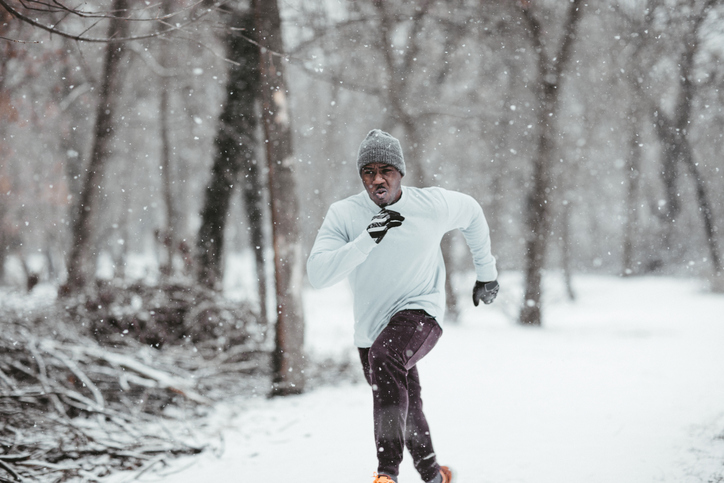Remember last summer when it was so hot, and you dreamed about cooler weather? Well, that time is here. Some runners stop their outdoor training once the cold winter weather sets in, and don’t resume until temperatures rise in March. That’s a huge mistake, as there are many benefits from training year-round, including during the coldest months. Following a few winter training principles, any runner can make the winter season one of their favorites.
Benefits of Winter Running
-
- If you’re a competitive runner, completing base training/long-distance workouts throughout the winter is one of the best ways to ensure fast times and success in the spring racing season. After building a base from mid-December (when the road race season winds down) to the end of February (when racing season starts in earnest), switching over to some speed workouts can help your racing times plummet.
-
- Getting outside can help beat the winter blahs. Regular exposure to sun has been proven to prevent seasonal affective disorder (SAD). Also, with closed windows and indoor air trapping more pollutants during the cold months, breathing fresh air is good for your health and mind. If your work schedule permits, run in the middle of the day, when the temperature and sun are highest. Even if you can’t run during lunchtime, just go outside during your break for a one- or two-mile brisk walk, perhaps while munching on some fruit and nuts, to relieve stress.
-
- You’ll enjoy social benefits. While the spring racing season has the peak races, beginning in March, local running clubs—the Peninsula Track Club, Colonial Road Runners, Tidewater Striders, Richmond Road Runners and Tri-Cities Road Runners—hold races almost every weekend throughout the year. It can be a lot of fun to run in winter races, which tend to be longer in distance and more low-key.
Winter Training Tips for Runners
-
- Use the 20-degree formula: Once you’re thoroughly warmed up, the clothes you wear for running should be similar to what you’d wear just standing or walking around with the temperatures 20 degrees warmer. For example, if you wear a short-sleeve T-shirt when the temperature is 70 degrees, you’d wear the same amount of clothing while running in 50-degree temperatures. And if you are wearing a long-sleeve T-shirt when it’s 60 degrees outside, you’ll wear the same shirt running when the temperature is 40 degrees. And a hooded sweatshirt at 50 degrees equals the same while running in 30-degree weather.
-
- Wearing sweat pants or “track pants” is one of the most important things you can do to avoid running injuries during the winter months. I suggest wearing something to cover the legs when temperatures fall under 70 degrees during warm-ups, under 60 degrees once warmed up and during regular running workouts, and under 50 degrees while racing.
-
- Dress warmly with layers that can be removed or adjusted during your workout, especially during your warm-up phase. Just getting out the door is one of the greatest challenges with winter running, and if you’re shivering at the start, you won’t want to go. Wear an extra layer (hooded sweatshirts are great) for the first half-mile or mile of your workouts, and wearing a short-sleeve shirt under a long-sleeve shirt is ideal. Once you warm up thoroughly, just remove the long-sleeve shirt and tie it around your waist. Other essential winter clothing can include a knit ski hat, earmuffs or headband, and running gloves. If you wear track pants with pockets, you can stuff the smaller items in the pockets once you are warmed up. Zippered tops are also good; you can adjust the opening depending on the wind and temperature. For rainy weather, wear waterproof running gear. And if it’s snowing, wear a baseball cap to keep the snow from stinging your eyes. The key here is to always avoid sweat-soaked clothing. As you warm up, remove the clothing layers before you start to sweat. Having wet clothes can make you feel too hot, then too cold, as well as uncomfortable during your workout.
-
- The worst winter running advice I’ve ever heard is to start your workouts running against the wind, so you can finish them with the wind behind you. I suggest the exact opposite. When you’re just starting out, your core temperature is low and you should run with the wind. When you’re thoroughly warmed up and your core temperature is higher, running against the wind becomes easier.
-
- If you’re running after dark, make yourself visible with reflective gear or running lights especially while running near traffic, and assume that the cars can’t see you. If running after dark, search out well-lit areas where traffic is at a minimum. You can often find soft surfaces on which to run, even at night, such as a high school or college track.
-
- So dress properly in layers, remove the layers as you warm up, and get out the door despite the cold. There’s nothing nicer than running on a cushion of one or two inches of snow, either on the roads or through the “winter wonderland” of woods or trails. And I’ve found it’s easier to balance while running on snow or ice than while walking on the same surface.

